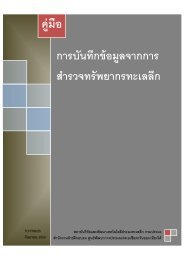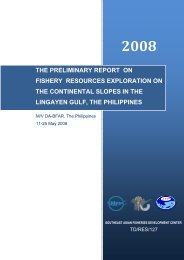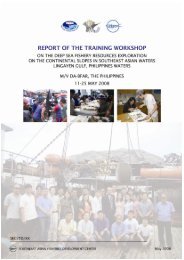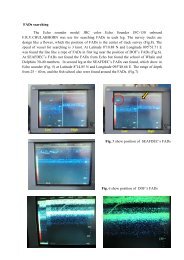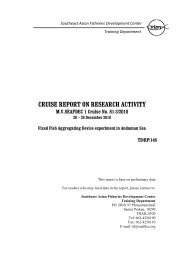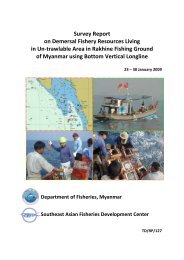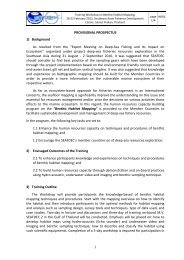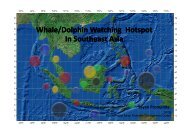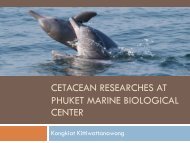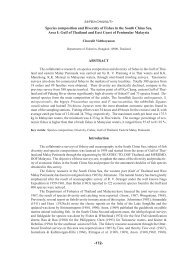Download - fisheries information system - Seafdec
Download - fisheries information system - Seafdec
Download - fisheries information system - Seafdec
You also want an ePaper? Increase the reach of your titles
YUMPU automatically turns print PDFs into web optimized ePapers that Google loves.
The Eco<strong>system</strong>-Based Fishery Management in the Bay of Bengal<br />
Validity of Methods<br />
Results and Discussion<br />
Table 2 shows determined values, certified value and % recovery of Hg, Cd, Cu, Pb,<br />
and Zn of certified reference material (DORM-3; National Research Council, Canada) and<br />
limit of detection of each heavy metal. The recovery levels of all heavy metals from this study<br />
were within an acceptable range (96-103%).<br />
Table 2 Determined value, certified value and percent (%) recovery of heavy metal contents<br />
of the DORM-3 (n=4) as validation for analytical technique.<br />
Metals/description Hg (ug/g) Cd (ug/g) Cu (ug/g) Pb(ug/g) Zn (ug/g)<br />
Determined value 0.415±0.011 0.292±0.024 16.03±0.34 0.405±0.025 49.51±0.39<br />
Certified value 0.409 0.290 15.5 0.395 51.3<br />
% recovery 101.58±2.78 100.59±8.16 103.43±2.19 102.74±6.56 96.50±0.768<br />
Detection limit b 0.001 0.003 0.030 0.012 0.090<br />
Heavy Metal Contents in Squid<br />
Heavy metal concentrations in the edible portion (mantle, arm and tentacle) and<br />
visceral mass of purpleback squid (Sthenoteuthis oualaniensis) from each station in the Bay of<br />
Bengal are shown in table 3. Mean concentrations±standard deviation of Hg, Cd, Pb, Zn and<br />
Cu in the edible parts of purpleback squid from all sampling stations were 39.92±34.10<br />
(ng/g), 3.759±4.856, 0.035±0.029, 16.54±2.32 and 10.99±8.60 (µg/g), respectively. Mean<br />
concentrations ± standard deviation of Hg, Cd, Pb, Zn and Cu in the visceral mass of<br />
purpleback squid from all sampling stations were 34.26±25.32 (ng/g), 17.47±5.70,<br />
0.062±0.020, 43.82±9.86 and 73.68±47.07 (µg/g), respectively.<br />
Panutrakul (unpublished data) determined heavy metal concentrations in mantle<br />
tissue of marbled octopus (Octopus aegina) and pharaoh cuttlefish (Sepia pharaonis)<br />
collected from the upper Gulf of Thailand. For octopus, concentrations of Hg, Cd, Pb, Zn and<br />
Cu were 12.12±5.59 (ng/g), 0.020±0.037, 0.126±0.169, 19.88±4.42 and 11.48±5.10 (µg/g),<br />
respectively. For cuttlefish, concentrations of the same group of metals were 15.39±8.03<br />
(ng/g), 0.055±0.072, 0.061±0.029, 13.5±2.47, 5.76±1.69 (µg/g), respectively. Mean<br />
concentrations of Hg, Pb, Zn and Cu in edible tissue of purpleback squid from the Bay of<br />
Bengal were similar to concentrations found in octopus and cuttlefish in Thailand. However,<br />
Cd concentrations in purpleback squid were much higher than in the other two species.<br />
Pierce et al. (2008) measured Hg and Cd concentrations in tissues of two loliginid<br />
(Alloteuthis sp. and Loligo forbesi) and two ommastrephid (Todarodes sagittatus and<br />
Todaropsis eblanae) squid species collected in UK waters during 2004-2005. They found<br />
concentrations of Hg and Cd in muscle tissue of the squid to be in the range of 17-80 ng/g and<br />
0.021-0.256 µg/g, respectively. However, the authors also reported that the digestive gland is<br />
the main storage organ of Cd in these squid species. Hg and Cd concentrations in the<br />
digestive gland of these squid varied from 17-110 (ng/g) and 0.16-3.31 (µg/g), respectively.<br />
In comparing results from this study with those of Pierce et al. (2008) we found that squid<br />
from UK waters show slightly higher Hg concentration in both muscle and digestive gland<br />
than our samples from the Bay of Bengal. Meanwhile, Cd concentrations in both muscle and<br />
digestive gland of squid from UK waters were lower than our samples.<br />
236



